Nikolaihof Wachau
by
Terry Sullivan
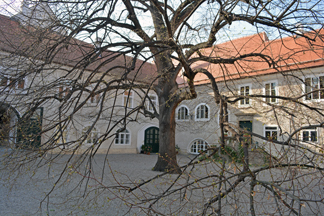 Summary: Nikolaihof is the oldest winery in Austria dating to the Roman times. It is also one of the first wineries in Austria to gain Demeter certification and follow biodynamic principles in the vineyards and winery.
Summary: Nikolaihof is the oldest winery in Austria dating to the Roman times. It is also one of the first wineries in Austria to gain Demeter certification and follow biodynamic principles in the vineyards and winery.
As we entered the Nikolaihof complex, we noticed a large courtyard surrounded by interconnected buildings. Off-center of the courtyard was a large linden tree with branches reaching down to the ground. The tree was just beginning to spring forth leaves and blossoms. Our contact at the winery talked about how beautiful the leaves on the linden tree would be in a couple of more weeks. Along the edges of the courtyard, two ladies appeared to relax and enjoy a glass of white wine on a bench in a sunny spot.
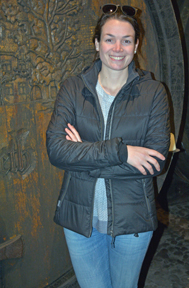 Soon we met Anna-Marie Lun who gave us an enthusiastic tour of the cellar and conducted our tasting. Anna is the partner of the winemaker Nikolaus Saahs Jr. Anna works in the office, conducts wine tastings and represents the winery at trade fairs.
Soon we met Anna-Marie Lun who gave us an enthusiastic tour of the cellar and conducted our tasting. Anna is the partner of the winemaker Nikolaus Saahs Jr. Anna works in the office, conducts wine tastings and represents the winery at trade fairs.
Center of the buildings surrounding the courtyard is a tall, narrow church. We learned that 2,000 years ago, this site was the Roman garrison Favianis. Some of the current walls were built in the second century. Anna mentioned that, "There are also younger parts of walls which still date back several hundreds of years." At the time, the Romans brought grapevines and planted vineyards in the Wachau region. In 777 the church became the owner of the winery and cellar. In 1803 the property became secularized and was privately purchased. Anton and Anna Saahs bought the property in 1894. The wine estate has since remained in the Saahs family. In 1971 Nikolaus and Christine Saahs began practicing the biodynamic methods. Today, the winery production has passed down to Nikolaus Saahs Jr.
Vineyards and Winery
Anna spoke of the vineyards. The winery owns 22 hectares (54 acres) of vineyards. The vineyards are named "Im Weingebirge,” "Vom Stein,” "Steiner Hund" and “Klausberg.” The main grape varieties planted are Riesling and Grüner Veltliner. There are also plantings of Neuburger, Gewürztraminer and Gelber Muskateller.
Biodynamic principles are followed in the vineyards including preparations of teas such as stinging nettle manure, valerian drops, horse tail tea and Nikolaihof develops their own specially produced Demeter-preparations. The biodynamic calendar is followed. For example they use the phases of the moon for planting and harvesting. No herbicides, pesticides or fungicides are used in the vineyards. Every other row in the vineyards are planted with cover crops. This helps insure a diversity of insects so harmful insects cannot establish a foothold.
In the winery, after a gentle pressing, native yeasts are used to ferment the wines. The wines then age in the cellar until ready for bottling. Behind the biodynamic principles in the vineyards and winery is a philosophy that the wines can give you more energy than you take.
Cellars
Anna took us on a tour of the cellars that date back 800 years. Our first stop above the cellars was a beam press made from an elm tree 350 yeas ago. The main arm of the press is 13 meters (43 feet) long. It was used until the 1980s. Today, it is only used to make the Baumpresse Grüner Veltliner. Anna described the process in detail.
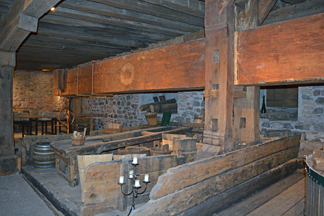
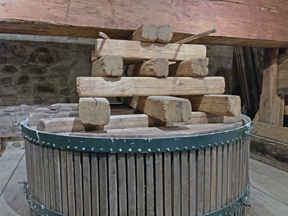
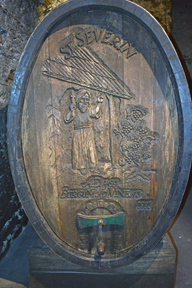 There are many oak casks in the cellar. Sizes included 2000, 6000 and 12,000 liters. The casks are used to age wines. The oldest wines have been in the casks for twenty years. The front end of the casks have beautiful carvings on them. The opening near the bottom of the casks is quite small. Anna assured us that we could crawl into the cask to clean it. She has done it and explained how to crawl in and out head first and one shoulder at a time.
There are many oak casks in the cellar. Sizes included 2000, 6000 and 12,000 liters. The casks are used to age wines. The oldest wines have been in the casks for twenty years. The front end of the casks have beautiful carvings on them. The opening near the bottom of the casks is quite small. Anna assured us that we could crawl into the cask to clean it. She has done it and explained how to crawl in and out head first and one shoulder at a time.
Wines
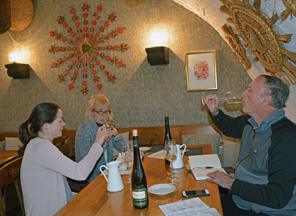 We tasted wines in a room with several tables. The walls are decorated with beautiful crafted signs that mean certain concepts such as when a facility is open. Heurigen - Stern (Heurigen star) is the symbol for a place where you can eat cold food and drink the wine of the house and it is open. The Hüter - Stern was the symbol of the people guarding the grapes in the vineyards. The appropriate sign is placed outside the entrance to the business.
We tasted wines in a room with several tables. The walls are decorated with beautiful crafted signs that mean certain concepts such as when a facility is open. Heurigen - Stern (Heurigen star) is the symbol for a place where you can eat cold food and drink the wine of the house and it is open. The Hüter - Stern was the symbol of the people guarding the grapes in the vineyards. The appropriate sign is placed outside the entrance to the business.
The 2015 Grüner Veltliner Smaragd Im Weingebirge Vineyard had 12.5% alcohol and a yellow color. The wine aged in oak casks for 1½ years. The aroma was floral. The wine had a velvety mouthfeel and was reminiscent of roses and daisies. The finish was crisp.
The 2014 Riesling Smaragd, Vom Stein Vineyard had a dark yellow color and 12.5% alcohol. The wine spent 2½ years in oak casks. The wine had a floral aroma. The silky taste reminded me of daisies and yellow stone fruits. The finish was crisp and fruity.
The 2012 Riesling, Klausberg Vineyard had a dark yellow color and 12.5% alcohol. Peach blossoms and apricots were on the aroma. The mouthfeel was velvety and the taste offered yellow stone fruit blossoms, peaches and apricots. The finish was crisp and fruity with a hint of mineral.
The 2013 Baumpresse Grüner Veltliner, Im Weingebirge was made by using the elm beam press to gently crush the grapes. The resulting wine had 12.5% alcohol and was a dark yellow color. The aroma included yellow stone fruits and flowers. The mouthfeel was velvety and was reminiscent of white peach blossoms and white peaches. The crisp finish was fruity with the fruit yielding to floral notes.
The 2002 Vinothek Riesling had 16 years of aging in oak casks. The 12.5% alcohol wine had a dark yellow color. Peaches were noted on the aroma, while the taste also included peaches. The wine had a velvety mouthfeel and a fruity finish.
We had the chance to taste an aged white wine. The 1986 Honigogo Grüner Veltliner had 13.7% alcohol and a light gold color. The floral aroma had a taste of blossoms and white peaches. The vibrant finish was floral and peachy with a very long aftertaste.
Between 70 and 80 percent of Nikolaihof Wachau wines are exported throughout the world including most states in the United States.
If you are planning a visit to the Wachau region in Austria, be sure to schedule a visit to the Nikolaihof winery.
Nikolaihof Wachau
Familie Saahs
Nikolaigasse 3
3512 Mautern, Wachau
Austria
Article written April 2019.
